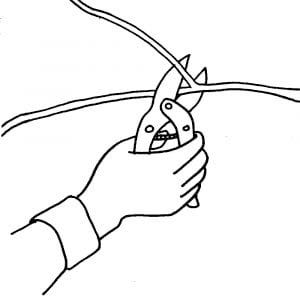Interesting word, prune. The noun you know, prune, is basically a dried plum, and they're very good for you; they help your vision, your heart, and your immune system. They're a great source of energy and dietary fiber - - they fight cancer too.
The verb, prune, is a different word with an entirely different origin. To prune is to remove unnecessary material, especially to make something more healthy or productive. A good gardener prunes, as does a good computer programmer and a good writer.
This post is in response to last week's "Gift Horses" post. There I discussed how an organization might respond to ideas from the outside - - say, for a new product - - whether good or bad.
How might one think about whether or not it is a good idea to ADD a new product? Let's take it further: How might one take a look at what they already have and then make the decision that some of it has to go? That is, to DELETE a product? These are related decisions. I'd say the decision to add a member to your staff, a product to your line - - to add anything, really - - is, ideally, married to the same decision process that would drive you to remove any thing.
Here is where pruning comes in. Pruning is a key competence of individuals and organizations. Cultivating an organizational culture that practices pruning is a key leadership challenge.
I'll use the pruning of trees and bushes as a metaphor for discussion of how we might decide when and what we should prune - - in our own, individual lives, and in our workplaces. What can we cut out of our own lives, our own work, and our organizations to make them more healthy and productive?
Do you have a pruning process in your life? Does your organization have one? Tell us in the comments?
Let’s start with the easiest cuts to make: The "Three Ds," dead, diseased, or damaged.
DEAD. There is little reason to leave these branches, on a tree or in an organization. Are there product SKUs with little to no sales? Do you have projects or prospects that are, well, inanimate? In the absence of some really important reason to keep these around, these should be swept away, out of your life, out of your organization. The only possible excuse not to do this immediately would be that you have some five alarm fire in your life or organization - - some urgent priority that puts this housekeeping off until later.
DISEASED. Like the dead wood, this wood will not thrive. In fact, this wood is worse, as diseased wood spreads disease. This “diseased” product, project - - even personnel - - will infect other, healthier parts of your life or organization. Are there individuals in your organization that are behaving in ways counterproductive to the rest? Might it be a process that is at fault? You know the adage, if you are doing something the wrong way, you are teaching others to do it the wrong way. It’s contagious. See these things for what they are: Immediately isolate, commit to treatment - - if you can, and if this fails, they’ve got to go.
DAMAGED. Something happened to damage a branch, something external: Maybe it was broken by a strong wind, snapped by heavy ice, or struck by a falling branch. Are you old enough to remember the videotape format war in in the late 1970s and the 1980s? Sony's Betamax - - the first market entrant - - eventually lost out to the ultimately more-popular VHS format. You see, the later entrant "damaged" Betamax's prospects, although many considered it the superior format. My HBS professor, Clayton Christensen, explored these ideas deeply in his work, including "The Innovators Dilemma". Sometimes the ultimate, winning product evolves from what started out as a lower-cost, more-common, and inferior product. It “disrupts” everything from its normal state. Does your organization have a product or a service, that, perhaps through no fault of its own, is damaged, irreparably, to the point it will never thrive? At what point should Sony have thrown in the towel on Betamax? At what point should the Betamax owner have switched over? When do you cut bait? Sensing these situations, and responding appropriately, are key leadership challenges.
Those are the easier cuts to make, the “easy prunes”.
The next three pruning commands are more difficult, mostly because they remove perfectly-healthy, strong branches - - branches whose very strength and vitality impedes the growth YOU want. Branches that cross, are acute, or have clusters must also be pruned.
CROSSING. What if you have two great teams of people, pursuing two great opportunities, AND you know that they will get in each other's way and compete for resources in an unhealthy way? This is crossing, where one branch of a tree is over the path of another. The branch over the other, when it bears fruit, will impede the other in doing so. It has crossed the path of the other branch. These must be removed such that the branch with the more direct path is not impeded.
ACUTE. "Acute" branches on a tree are those that rocket straight upward, but they won’t bear fruit well. The “tree” has no breadth, no strength, and has limited growth prospects. In our lives and organizations, we see projects like this, momentary, flashes-in-the-pan, exciting, but not strong, long-term prospects. They must go.
CLUSTERS. Take your hand and make a fist. Point it upward. Now open your fingers. See that bloom-like structure? That's a cluster. It's a kind of maladaptation where there is too much growth originating from one point on the branch. You’d be crazy to put all of your best people on one project, right? To put all your budget on that project? To put all your effort on one client? Same thing. Nature shouldn’t, and does not normally, cluster all of its soldiers in one spot, nor should you. Break it up, prune.
How have you made these cuts in your own life or organization? Have you been pruned? What was that like, and what did you learn from that? Share in the comments.
Once a year, early in the spring, I walk every inch of the thick woods on my land. I pick "winners". This is “pruning” in the extreme. Sometimes, you will have two equally-good, strong, young trees - - maybe ten feet tall - - mere inches away from each other. It is painful to kill a perfectly good tree, but I must, so I'll take one out so the other may thrive. It’s for all them, for the health of the whole woods. See the forest, not merely trees: Cultivate that mindset when you prune your world, as an individual and as a part of a larger organization.
Earlier in my career, right after BCG, I took a Chief Operating Officer position that I quickly realized was instead a fire fighting job - - an emergency, a turnaround situation. I will never forget the meetings we leadership had with potential rescuers, purchasers, and investors. An older, wise leader of a competitor firm asked my boss, "Do you really want to keep this? Do you really want to save this and run it by and for yourself? … You can." Then he said, "You'd have to cut everything down to the ground, to the root ball." He was asking us if we could prune. He was saying we'd have to let go of nearly all the staff, nearly all the clients, and start back from the very basic roots of the company. Then, maybe, we'd have a chance to remain alive AND independent.
What that wise man described is called "rejuvenation pruning", and it involves removing all the branches, all the way down to a few inches from the plant’s root ball. This is done when regular pruning can no longer solve the problem. It is grave, and the plant often doesn’t survive.
Leadership must prune and foster a culture of pruning, lest the organization arrives at the point where the only way to save it is to cut down to the root ball. Don’t let it get that far.






